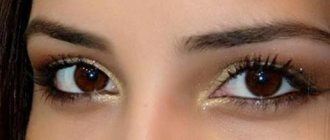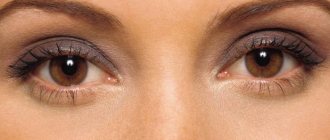Many people want to know where green eyes came from. Science suggests that previously, several thousand years ago, all people had brown eyes. But due to mutations, new colors have appeared, which are now divided into eight main color types. This trait really depends on genetics and is determined by the following factors.
- Pigmentation of the iris.
- How light is scattered around the iris.
Different people have different or even unique shades of green eyes. The coloring is not always uniform and often includes spots.
Iris of green shades
Iris pigmentation can range from black-green (dark green eye color) to light shades, which is largely influenced by melanin. This is a pigment produced during the oxidation of tyrosine (an amino acid) and further complex reactions. The emerging shades of jade, hazel and emerald eye colors can be based not only on a certain amount of melanin in the iris. This is the result of the scattering of light producing shades through the process of reflection. Light green eye color corresponds to a lower concentration of melanin pigment. But when reflected from its particles, light waves produce shades of blue or cyan. Green eye color is determined by a small amount of melanin, which can appear as hazel, emerald, amber or gray due to scattering of the rays.
The iris consists of two layers: anterior and posterior (mesoderm and ectoderm). The first includes so-called chromatophores containing the pigment melanin. Its quantity and distribution determines the color. The outer layer also contains yellow and light brown pigment (lipofuscin). The posterior layer contains pigment cells with a blue dye. This part always gives a darker shade. Mixing the two colors from the layers forms the green color of the iris. Pigment granules are also sometimes found on the iris, giving green eyes spots or dots.
bobot 08/09/201203/20/2019 Category MiscellaneousTags states, girls, Italy, paint, mania, taxes, sky, organism, planets, colors Comment.
A person has an eye color that he inherited. There are not so many basic color options, but there are a large number of shades.
The iris consists of ectodermal and mesodermal layers. The color depends on the distribution of pigments in them.
Most people on the planet have brown eyes, the rarest eye color is green. According to statistics, only 2% of the world's population have green eyes. This color, however, like any other, is determined by the amount of melanin in the body; green-eyed people have less of it, people with brown eyes have more of it. The fact that green eye color is very rare is also a consequence of the “work” of the medieval Inquisition, when red-haired girls with green eyes were considered witches and were burned at the stake.
Green eye color and its shades from gray-green to emerald are common among eastern and western Slavic peoples, in particular the Germans and Scots. But not only. For example, among the residents of Iceland, a small island state, almost 80% of the population has green or blue eyes, in Turkey almost 20% of residents have green eyes, but in the countries of South America, Asia, and the Middle East, green eye color is practically not found.
Basic eye colors in people
Blue
The ectodermal layer is dark blue in color. This color is the outer layer of the vessels of the iris, formed from collagen fibers. If the fibers of the outer layer of the iris are low density and have low melanin content, then low-frequency light is absorbed by the back layer, and high-frequency light is reflected from it, so the eyes turn out blue. Most babies have blue eyes in the first few months of life. This phenomenon is common even among the countries of the Middle East, where pigmentation is quite high.
See also: Careprost will make you look much longer
Blue eye
Unlike blue eyes, in this case the fiber density of the outer layer is higher. Since they have a whitish or grayish tint, the color will no longer be blue, but blue. The higher the fiber density, the lighter the color. This eye color is most common among Germanic countries, less often in East Slavic countries.
Blue eye color is the result of a mutation in the HERC2 gene, due to which carriers of this gene have reduced melanin production in the iris of the eye. This mutation arose approximately 6-10 thousand years ago. Most common in the Scandinavian countries, northern Germany, Belarus, northern Poland and northwestern Russia.
Gray eye (steel shade)
The definition of gray and blue eyes is similar, only the density of the fibers is even higher and their shade is closer to gray. If the density is not so high, then the color will be gray-blue. In addition, the presence of melanin or other substances gives a small yellow or brownish impurity. This eye color is most common among eastern and western Slavic peoples, in particular among Russians, also among Western Europeans of the Alpine type (Bavaria, northern Italy), among some inhabitants of the Mediterranean and Jews.
See also: Taiwanese scarf
Green eye
Green eye color is determined by a small amount of melanin, and the red hair gene may also play a role here. The outer layer contains a yellow or light brown substance that may be associated with a certain disease. Since the back layer is blue, the result is green, so isolating this color into a separate shade is controversial. The color of the iris is usually uneven and there are many different shades. Distributed among Germanic, eastern and western Slavic peoples, most intensely among the Scots.
Amber eyes
Amber eyes have a monotonous light brown color and a yellowish-green, sometimes slightly reddish tint. Sometimes their color is close to marsh or golden. This is caused by the pigment lipofuscin. This type of eye is widespread among Germanic, Romanesque peoples, South Slavs, Greeks and occasionally Middle Eastern peoples.
Swamp Eye
Swamp eye color, in English terminology called hazel, is a mixed color. Depending on the lighting, it may appear golden, brown-green, brown. In the outer layer of the iris, the content of melanin is quite moderate; in addition to it, other substances are often present. Unlike amber, in this case the color is not monotonous, but rather heterogeneous. This type is widespread among the peoples of Western and Eastern Europe, as well as among northern Indians and, less commonly, Middle Eastern peoples.
Brown eye
In this case, the outer layer of the iris contains a lot of melanin. Therefore, it absorbs both high-frequency and low-frequency light, and the reflected light adds up to brown. This eye color is widespread among Romanesque peoples, as well as among Semites, Berbers, Turkic peoples, Indians and northeastern Mongoloids. Less common among Germanic peoples. Brown is the most common eye color in the world.
See also: Unknown facts about the work of the FBI
Black eye
The structure of the black iris is similar to the brown one, but the concentration of melanin in it is so high that the light incident on it is almost completely absorbed. Often, in addition to the black iris, the color of the eyeball can be yellowish or grayish, which is typical for all blacks or other peoples with black skin. This type is widespread primarily among the Negroid race, peoples of the Middle East, South Asians, Australoids and South Indians. Among Northern European peoples, this eye color is completely absent. And if there is, then it is exotic.
If you find an error, please select a piece of text and press Ctrl+Enter.
BraveRobot found more articles on this topic:
- Makeup Tips for Green Eyes
- Selecting shadows for blue eyes
- Makeup for brown eyes
- Makeup for gray eyes
- Makeup for gray eyes: basic rules and tips
- Animal eyes glowing in the dark: why does this happen?
- Eyeshadow Tips
- The most interesting facts about the eyes
- Nuances of blue shadows: temptation and attractiveness of the look
- Why does skin come in different colors?
Factors influencing eye color: brown-green, emerald and others
So, the following factors can influence the shades of green in the eyes.
- Lighting: natural or artificial, the intensity of light falling on the iris enhances or weakens the color of the iris.
- Time of day differing in the intensity of sunlight.
- The reflection of colored objects around a person, for example, fabrics, clothes, enhances the natural color of the eyes. Gold and blue, through reflection, can make specks on the iris visible.
- Makeup and shadows of various shades highlight the natural green. How to emphasize green eye color? It can even lead to a chameleon effect.
- Allergies can change the color of the sclera (the white part of the eye that surrounds the iris). The eyes will become red and inflamed, which will enhance the color through contrast. Bags under the eyes are also not decorative; this is undesirable.
- Emotional state can change eye color through feelings. A dilated pupil and tears make the iris appear darker.
- The influence of substances: alcohol, antidepressants, drugs enlarge or reduce the pupils. The resulting color becomes intense.
Caution: If your eye color changes unexpectedly, suddenly, or your pupils dilate for a long time, you should consult a doctor.
What eye color is dominant in a person: green or blue, gray?
- Chromosome 19 contains the type of allele responsible for blue and green color. Gray or blue tones are derived from the blue-eyed gene. In nature, the green-eyed species is dominant over the blue-eyed recessive color.
- Blue eye color is determined by a high genetic indicator on chromosome 15 , which makes it possible to obtain different color options. If both parents are green-eyed in gene 19, the child will receive the same eye color , in a pair of green-eyed and blue-eyed , green predominates, two blue-eyed parents will produce a blue-eyed child. But if there is at least one dark-eyed variant in gene 15, the child will be born brown-eyed.
Eyes
Genes: what does green eye color mean?
There are old and new gene theories. According to the first, scientists have long believed that eye color is determined by one dominant gene (brown). The hierarchy of colors comes from brown and blue. That is: dad has brown eyes, and mom has blue eyes, then the child will be born with brown or variegated eyes. And also the situation is also partly influenced by recessive genes (that is, blue, non-dominant). Green eye color appears more often in children if both parents have the same color.
What does green eye color mean according to the new theory? In a 2008 publication in the American Journal of Genetics, the old understanding of eye color is rethought. It turns out that about 16 genes influence the color of the iris. Popularly speaking, a child may have eyes of any color, even different from the parent’s.
Although people of any nationality can have green eyes, there is a higher likelihood among residents of the Middle East (for example, the Russian Federation), Spaniards, Brazilians, and North Africa. Eye color brown-green or with an emerald tint still remains rare.
Can the color of the iris change (grey-blue-green eye color)?
Many people will be surprised that eye color can change, but this is true. It has been proven that people with blue, brown and green eyes sometimes experience discoloration. The reasons may be as follows.
- Change in light scattering.
- Under the influence of mood, significant lifestyle changes.
- As a result of health-related changes.
For example, eye color can change permanently if you are diagnosed with glaucoma and take appropriate medications. If a person has slightly green eyes and wants to maintain this color, they should be careful with glaucoma medications. Regarding such facts, you should consult your doctor. Changes in eye color are often found in babies as they grow older. So gray-blue-green eye color is a reality.
Health risks of green eyes
People with green eyes are highly susceptible to harmful sun rays, which is due to melanin. Forms of cancer may develop: ocular and intraocular melanoma. Those with light eyes should wear sunglasses outdoors in summer.
Amber eye color
First of all, it’s worth saying a few words about what affects the shade of the iris. Eye color depends on the thickness of the membrane fibers and the level of concentration of melanin pigment in it. The more dye and the denser the fiber, the darker the iris.
The yellow color of the eyes indicates a low concentration of pigment in the membrane. There is little of it, but it is there. The fibers have a small thickness. As a result, the iris becomes golden brown, sometimes with a reddish or orange tint. Sometimes amber eyes look yellowish and resemble the eyes of a wolf or tiger.
Those with such an unusual color have not only melanin in their iris, but also lipofuscin (lipochrome), which gives it a mysterious shade. Orange eyes look especially beautiful if a dark ring is formed around the shell. As a result, a person’s gaze becomes piercing and deep.
| Amber eyes are extremely rare; around the world, about two percent are yellow-eyed. Some people sometimes confuse hazel and orange iris, although they are different. Yellow eyes lack a green tone and are dominated by light brown. |
Return to contents
A bit of genetics
The shade of the iris is determined at the genetic level. A dominant gene is responsible for dark color, and a recessive gene for light color. As a result, it turns out that a person with yellow eyes carries one or a couple of copies of the dominant in the karyotype. Therefore, a father and mother with a light iris cannot give birth to a baby with amber eyes.
As the child grows older, the shade of the eyes changes. Those with a yellow iris are born with a dark gray and cloudy iris. Gradually it brightens and acquires a magical color.
Since individuals with golden eyes have little melanin in their bodies, they most often have light brown or brown hair and snow-white skin, which often has freckles. There are also red-haired people with amber eyes. This combination looks unique, because the curls and eyes have an almost identical shade.
Psychological impact
People with yellow eyes are a real curiosity; they are extremely rare. For this reason, their appearance seems mysterious and attractive to those around them. The amber iris looks very light; its owner gives the impression of an open and good-natured person. At the same time, it seems that some kind of mystery is hidden in it.
Yellow and orange shades are considered to be symbols of happiness and optimism. Perhaps for this reason, people with golden eyes always look cheerful, capable of overcoming any difficulties.
The amber color of the iris attracts the attention of the opposite sex, it is not for nothing that many young ladies buy such contact lenses. Our ancestors were sure that those with yellow eyes were endowed with magical abilities: they could read thoughts and control the actions of those around them.
Individuals with golden eyes are artistic people who love to be the center of attention. They are dreamers and often fly in the clouds. To succeed in their career, they need to find something they love. Otherwise, they will do the job carelessly.
| Yellow-eyed people are honest with others, will never manipulate the feelings of others and always tell only the truth to their face. |
Why are people with green eyes unique?
Green eyes are nice to look at. They are also quite rare, occurring in only 2% of the world's population. Out of a total population of 7 billion people, only 140 million have green eyesight. This is true for many celebrities, such as Tom Cruise. What does green eye color mean? There are myths about this iris color. Green eye color, the meaning of which is associated with prejudice, sometimes expresses the following characteristics:
- such people are considered loving, have intense relationships, or are very attractive;
- sometimes they are credited with mystical abilities;
- it is assumed that green-eyed people prefer a healthy lifestyle.
Two different people, unless they are twins, cannot have the same eye color. Science believes that in the process of evolution this trait is an adaptation to the environment. Now you can buy any contact lenses, making your eyes green-brown or another color. This coloring of the iris is apparently a great success for its owners.
Witch eyes
Green eyes are unique not only because of nature’s reluctance to replicate such beauty. People themselves made their contribution to the destruction of their green-eyed brothers in the Middle Ages. Mass terror was then carried out by the Holy Inquisition. Most of all went to the beautiful women with secret knowledge with those same green eyes.
It is not known exactly when and why humanity began to consider such ladies as witches (perhaps due to the fact that they were rare and made a strong impression). Over the 300 years of the fury of the Inquisition, about 40-50 thousand people burned at the stake. The bulk of them were green-eyed women and men who corresponded to the description of a “true witch.”
All of them were carriers of those same unique genes. So before the start of the mass psychosis called the “witch hunt” in Western and Eastern Europe, there were many more people with such rare and beautiful emerald eyes.











